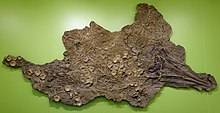
Back Acamptonectes German Acamptonectes Spanish دلفین دنسوس FA アカンプトネクテス Japanese Acamptonectes Dutch Acamptonectes SIMPLE Acamptonectes VI
| Acamptonectes Temporal range: Hauterivian
~ | |
|---|---|

| |
| Specimen SNHM1284-R in State Natural History Museum, Braunschweig | |
| Scientific classification | |
| Domain: | Eukaryota |
| Kingdom: | Animalia |
| Phylum: | Chordata |
| Class: | Reptilia |
| Order: | †Ichthyosauria |
| Family: | †Ophthalmosauridae |
| Subfamily: | †Ophthalmosaurinae |
| Genus: | †Acamptonectes Fischer et al., 2012 |
| Species: | †A. densus
|
| Binomial name | |
| †Acamptonectes densus Fischer et al., 2012
| |
Acamptonectes is a genus of ophthalmosaurid ichthyosaurs, a type of dolphin-like marine reptiles, that lived during the Early Cretaceous around 130 million years ago. The first specimen, a partial adult skeleton, was discovered in Speeton, England, in 1958, but was not formally described until 2012 by Valentin Fischer and colleagues. They also recognised a partial subadult skeleton belonging to the genus from Cremlingen, Germany, and specimens from other localities in England. The genus contains the single species Acamptonectes densus; the generic name means "rigid swimmer" and the specific name means "compact" or "tightly packed".
The generic name refers to unusual adaptations in the body of Acamptonectes that made its trunk rigid, including tightly fitting bones in the occiput (back and lower part of the skull) and interlocking vertebral centra ("bodies" of the vertebrae), which were likely adaptations that enabled it to swim at high speeds with a tuna-like form of locomotion. Other distinguishing characteristics include an extremely slender snout and unique ridges on the basioccipital bone of the braincase. As an ichthyosaur, Acamptonectes had large eye sockets and a tail fluke. Acamptonectes was similar in morphology to the related but earlier ophthalmosaurines Ophthalmosaurus and Mollesaurus.
The discovery of Acamptonectes had significant implications for the evolutionary history of ichthyosaurs. The generalised platypterygiine ophthalmosaurids were long believed to be the only lineage of ichthyosaurs that survived into the Early Cretaceous following a mass extinction of ichthyosaurs across the Jurassic–Cretaceous boundary. As one of the first-known ophthalmosaurine ophthalmosaurids from the Early Cretaceous, the discovery of Acamptonectes provided evidence against such a mass extinction. Although the larger eyes of Acamptonectes would have made it better adapted than platypterygiines to depth diving, it was probably a generalist predator. Its teeth, which were slender and textured with longitudinal ridges, were adapted for impaling prey, which suggests it likely fed on soft, fleshy prey such as fish and squid.